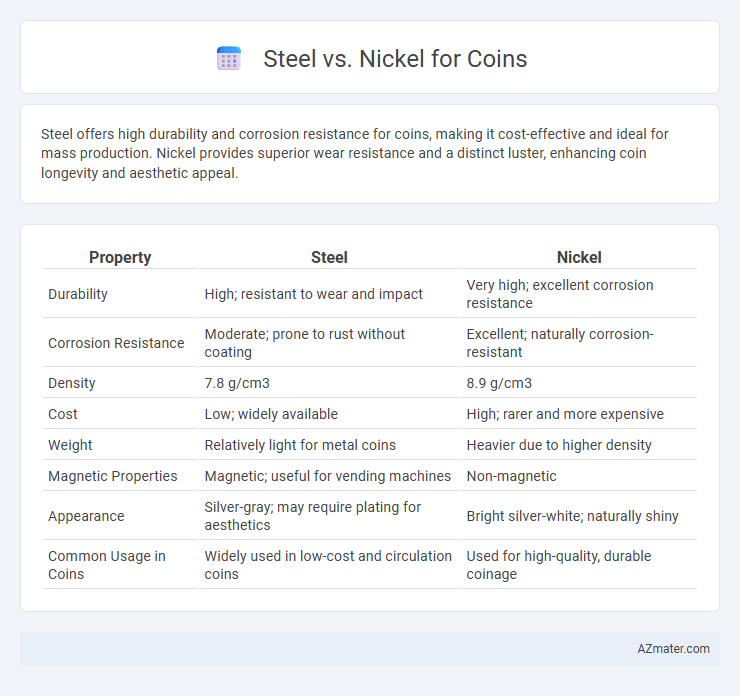Steel offers high durability and corrosion resistance for coins, making it cost-effective and ideal for mass production. Nickel provides superior wear resistance and a distinct luster, enhancing coin longevity and aesthetic appeal.
Table of Comparison
| Property | Steel | Nickel |
|---|---|---|
| Durability | High; resistant to wear and impact | Very high; excellent corrosion resistance |
| Corrosion Resistance | Moderate; prone to rust without coating | Excellent; naturally corrosion-resistant |
| Density | 7.8 g/cm3 | 8.9 g/cm3 |
| Cost | Low; widely available | High; rarer and more expensive |
| Weight | Relatively light for metal coins | Heavier due to higher density |
| Magnetic Properties | Magnetic; useful for vending machines | Non-magnetic |
| Appearance | Silver-gray; may require plating for aesthetics | Bright silver-white; naturally shiny |
| Common Usage in Coins | Widely used in low-cost and circulation coins | Used for high-quality, durable coinage |
Introduction: The Importance of Coin Composition
Coin composition significantly influences durability, corrosion resistance, and overall lifespan in circulation, making material choice critical for optimal performance. Steel provides high strength and cost-effectiveness but is more prone to rust without protective coatings, while nickel offers superior corrosion resistance and a longer-lasting finish. Understanding these material properties helps mints produce coins that maintain appearance and functionality under heavy use.
Historical Background of Coinage Materials
Steel and nickel have played pivotal roles in the evolution of coinage materials, with steel becoming prominent during resource shortages in the 20th century, especially in wartime economies. Nickel's durability and corrosion resistance made it a favored choice from the 19th century onwards, notably in U.S. five-cent coins and Canadian nickels. The historical shift from precious metals to base metals like steel and nickel reflects economic changes and advancements in minting technology.
Chemical Properties: Steel vs Nickel
Steel, primarily composed of iron and carbon, exhibits strong magnetic properties and high tensile strength due to its crystalline steel structure. Nickel, a corrosion-resistant transition metal with a silvery-white appearance, offers superior oxidation resistance and excellent ductility, making it ideal for coin plating and alloys. The chemical inertness of nickel enhances coin durability, whereas steel's susceptibility to rust requires protective coatings to prevent oxidation.
Durability and Wear Resistance Comparison
Steel coins exhibit superior durability due to their high tensile strength and resistance to deformation under repeated handling and environmental exposure. Nickel coins offer enhanced wear resistance because of their corrosion-resistant properties, which prevent surface degradation and maintain luster over extended circulation periods. The choice between steel and nickel for coin production depends on balancing cost-effectiveness with longevity in various climatic conditions.
Cost and Economic Impact of Steel and Nickel
Steel coins offer a significantly lower production cost compared to nickel due to the abundance and cheaper extraction process of steel, making them economically favorable for mass minting. Nickel, though more expensive, provides greater corrosion resistance and durability, often justifying its higher cost in coins intended for long-term circulation. The economic impact of using steel includes reduced material expenses and lower environmental costs, while reliance on nickel can lead to higher demand pressures and price volatility in the market.
Manufacturing Processes and Efficiency
Steel coins benefit from lower material costs and higher availability, enabling faster production with reduced expenditures in minting processes. Nickel, prized for durability and corrosion resistance, demands more complex alloying and finishing steps, which can slow manufacturing and increase equipment wear. Manufacturing efficiency favors steel due to its magnetic properties simplifying sorting, while nickel's superior hardness requires advanced tooling and longer production cycles.
Environmental and Sustainability Considerations
Steel coins offer a lower environmental footprint due to the abundance and recyclability of iron, reducing mining impacts and energy consumption compared to nickel. Nickel mining often involves extensive extraction processes that generate higher greenhouse gas emissions and toxic waste, posing greater ecological risks. The use of steel supports sustainable coin production by facilitating closed-loop recycling systems, minimizing resource depletion and enhancing circular economy practices.
Magnetic Properties and Practical Implications
Steel coins exhibit strong magnetic properties due to their iron content, enabling easy sorting and detection in vending machines and coin-operated devices. Nickel coins, generally non-magnetic or weakly magnetic depending on the alloy composition, offer less reliable magnetic response but provide superior corrosion resistance. The choice between steel and nickel for coins impacts their practicality in automated systems, durability, and maintenance costs, with steel favoring magnetic utility and nickel emphasizing longevity.
Security Features and Counterfeit Prevention
Nickel coins offer superior security features compared to steel coins due to their compatibility with advanced electromagnetic signature technology used in vending and authentication machines. Steel coins are more prone to counterfeiting because their magnetic and physical properties can be easily replicated with cheaper materials, leading to less effective counterfeit prevention. The durability and consistent conductivity of nickel enhance the reliability of security measures, making nickel a preferred choice for high-value currency requiring robust anti-counterfeiting protections.
Conclusion: Choosing the Right Metal for Modern Coins
Steel offers cost-effectiveness and corrosion resistance, making it ideal for low-denomination coins subject to heavy circulation. Nickel provides superior durability and a lustrous finish, enhancing coin longevity and aesthetic appeal in premium issues. Selecting the right metal depends on balancing budget constraints with desired durability and visual qualities for modern coin production.

Infographic: Steel vs Nickel for Coin
 azmater.com
azmater.com